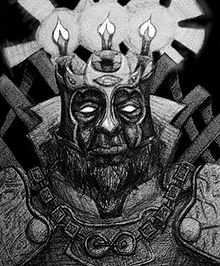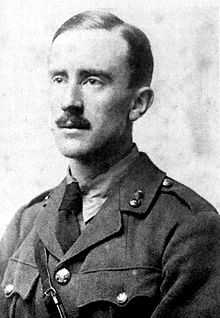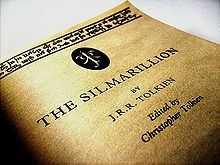Ainulindalë
| The Silmarillion |
|---|
"Ainulindalë" (Quenya: [ˌɑi̯nuˈlindɑlɛ]; "Music of the Ainur") is the first story in J. R. R. Tolkien's fantasy collection, The Silmarillion. In Tolkien's legendarium, the Ainur compose the great music before time begins; although Melkor disrupts the harmony and corrupts the initial two themes, he is unable to corrupt the third theme. The music of the Ainur creates Arda, and the Ainur begin to prepare for the arrival of the Children of Ilúvatar (the Elves and the Men) on Arda.
Tolkien wrote the initial version of "Ainulindalë" from November 1919 to the spring of 1920 as "Music of the Ainur", completely rewriting it in 1930. After further revisions by the author, it was published by his son Christopher in The Book of Lost Tales (the first two volumes of The History of Middle-earth). Reviews of "Ainulindalë" have been generally positive, with the difference in writing style between this story and the rest of The Silmarillion a subject of debate.
Synopsis

"Ainulindalë" recounts the creation of Arda by the deity Eru Ilúvatar. The story begins with a description of the Ainur as "children of Ilúvatar's thought". They are taught the art of music, which becomes the subject of their immortal lives. The Ainur sing alone or in small groups about themes given each of them by Ilúvatar, who proposes a "great" plan for them all: a collaborative symphony where they would sing together in harmony. Although the Ainur embody Ilúvatar’s thoughts, they are expected to use their freedom to assist the development of the "great" plan.
The most powerful of the Ainur, Melkor, is introduced to the music. Although his "loud, and vain" music disrupts the harmony, Ilúvatar stands, smiles and raises his left hand to begin a new theme. When Melkor again spoils the second theme, Ilúvatar rises sternly and raises his right hand to begin a third. Melkor tries to corrupt this theme with the volume of his music, but it is powerful enough to prevent him from succeeding. Ilúvatar ends the music, chastises Melkor and leaves the Ainur to their thoughts.
The deity takes the Ainur to see how music, at the end of the Void, created Arda. When the third theme results in the arrival of the Children of Ilúvatar, the Elves and the Men, many Ainur want to go into the world to visit them. Although Melkor was the first of the Ainur to be named, Ulmo was the first to take action in Arda. Despite Melkor's efforts, Ulmo's water cannot be ruined by heat or cold; he and Manwë are revealed as the primary agents of Ilúvatar's plans.
Some Ainur remain in the Timeless Halls with Ilúvatar, and others go into Arda as the Valar and Maiar. The Ainur begin to prepare for the arrival of the Children of Ilúvatar; Melkor repeatedly thwarts their preparations, desiring to rule Arda. Manwë summons the Ainur to resist Melkor, who retreats. When the Valar later assume bodily form the first war of Eä begins, but Manwë's efforts make the Earth habitable for Elves and Men.
Writing

The first version of "Ainulindalë" (known as "The Music of the Ainur") was intended to be part of Tolkien's The Book of Lost Tales, written in the 1910s and 1920s and published by Christopher Tolkien in the first two volumes of The History of Middle-earth.[1] According to a 16 July 1964 letter to Christopher Bretherton, Tolkien wrote the first version of "Ainulindalë" from November 1918 to the spring of 1920 while he worked on the Oxford English Dictionary.[2]
The first draft of the story, written in pencil, does not vary significantly from the published version; future changes involved the addition of Manwë and Aule.[3] The narrator in the earlier version is elf Rúmil of Tirion and the language differs from that of the Silmarillion version. "Melkor" is spelt "Melko", and Ilúvatar weeps before he creates the third theme. At the end is a section about the Valar, which was later moved to "Valaquenta".[3]
Tolkien abandoned Ainulindalë for many years. Although it did not appear in "Sketch of Mythology", in which he summarized his legendarium in 1926 to a professor in Birmingham,[4] the subject was briefly mentioned in "Annals of Valinor" and "Quenta Silmarillion". Tolkien rewrote "The Music of the Ainur" during the 1930s, leaving most of its storyline intact.[5]
In 1946, while drafting The Lord of the Rings, he wrote a new version of "Ainulindalë" of which only half a torn page survives. His legendarium then changed radically; Arda has always existed, the Sun existed when the world was formed and the Moon was formed as a result of Melkor's destruction.[6] Tolkien's Lamps of the Valar concept was abandoned in favour of a more coherent creation myth, with scientific elements. The idea of a spherical world was also abandoned after a reader said she preferred a flat one.[6][7]
In 1948 Tolkien began a new version, eliminating mentions of the Sun and the Moon and introducing the concept that Ilúvatar created the world after the visions of the Ainur died away. In this version, which added several new details,[8] the narrator is the elf Pengoloð.[9]
Criticism
Although commentary about The Silmarillion has primarily focused on the work as a whole, the reaction to "Ainulindalë" has been generally positive. British writer Joseph Pearce called it "the most important part of The Silmarillion" and said, "The myth of creation is perhaps the most significant and most beautiful of Tolkien's works."[10] Brian Rosebury considered "Ainulindalë" a success, with "appropriately 'scriptural'" prose.[11] Several Jesuits have praised the story; James V. Schall said, "I have never read anything as beautiful as the first page of The Silmarillion" and Robert Murray said, "In all literature, from the formation of the sacred books of humanity, it is very difficult to find a comparable mythological story of creation by its beauty and imaginative power."[10]
According to Fantasy Literature: A Core Collection and Reference Guide, "Every part of [The Silmarillion] benefits from the power and audacity of imaginative genius Tolkien and his brilliant style" and "Ainulindalë" has "organ tones".[12] Although Ralph C. Wood called it "one of the finest and most original of [Tolkien's] writings",[13] the stylistic differences between this story and the rest of The Silmarillion have been the subject of debate;[14] Daniel Grotta believes that Christopher Tolkien wrote most of the story.[15]
Analysis

"Ainulindalë", written early in Tolkien's career, demonstrates the importance of music in his legendarium.[16] According to John Gardner, "Music is the central symbol and the total myth of The Silmarillion, a symbol that becomes interchangeable with light (music's projection)."[17]
"The Music of the Ainur", as it appears in The Book of Lost Tales, refers to Norse mythology. Like Theogony and Gylfaginning in the Prose Edda, it answers cosmogonical questions.[18] The story's style has been compared to that of old Norse texts. Although the wording differs substantially, the Valar and the Æsir are alike in influencing the world and being influenced by their actions; Manwë has been compared to Odin in this context.[19]
Despite the story's Norse pagan elements, such as the Ainur performing the creative work of Ilúvatar, other aspects of "Ainulindalë" reflect Tolkien's Catholicism.[20] His pre-Christian story[20] has been called "Tolkien's Genesis essay";[21] according to another source, "The Biblical parallels evinced by the creation account of the Ainulindalë ... are inescapable."[22]
Marjorie Burns, who worked on the different versions of "Ainulindalë", said that Tolkien increasingly Christianised the Valar and reduced the influence of Norse mythology in successive revisions.[23] In the story Tolkien expresses a global view of Christianity, with good and evil paralleling the stories in the Book of Genesis.[13] As Gandalf says to Frodo Baggins, "There was nothing bad in the beginning, even Sauron was not."[24] In "Ainulindalë", Ilúvatar creates everything good; evil intrudes later.[25]
Legacy
Adam C. J. Klein composed an opera, Leithian, based on The Silmarillion[26] and Frank Felice composed an orchestral version of "Ainulindalë".[27] According to Colin Duriez, "Ainulindalë" may have inspired C. S. Lewis to have Narnia (his fictional world) created from a song.[28]
See also
Notes
- ↑ Tolkien 1984, p. 67.
- ↑ Tolkien 1981, p. 345.
- ↑ 3.0 3.1 Tolkien 1984, pp. 88–90. Christopher Tolkien described the difference between the initial and final versions of Ainulindalë.
- ↑ Tolkien 1986, p. 42.
- ↑ Tolkien 1987, p. 155.
- ↑ 6.0 6.1 Tolkien 2002, pp. 4—6.
- ↑ Tolkien 2002, pp. 369—371.
- ↑ Tolkien 2002, pp. 3—44.
- ↑ Tolkien 2002, pp. 29—30.
- ↑ 10.0 10.1 Pearce 1998, pp. 87—89.
- ↑ Rosebury 1992, p. 97.
- ↑ Tymn, Zahorski & Boyer 1979, p. 167.
- ↑ 13.0 13.1 Wood 2003, p. 11.
- ↑ Smith 1986, p. 866.
- ↑ Grotta 1992, p. 161.
- ↑ Bradford Lee Eden (2004). "The Music of the Spheres: Relationship between Tolkien's Silmarillion and Medieval Religious and Cosmological Theory" in Chance 2002
- ↑ Gardner 1977.
- ↑ Le Berre 2004, p. 344.
- ↑ Vos 2011.
- ↑ 20.0 20.1 Gough 1999.
- ↑ Bramlett & Christopher 2007, p. 36.
- ↑ Fisher 2011, p. 47.
- ↑ Marjorie Burns. "All in One, One in All" in Agøy 1998.
- ↑ Tolkien 1954, Chapter 2.
- ↑ Brian Rosebury. "Good and Evil" in Drout 2007, p. 250.
- ↑ Eden 2010, p. 161.
- ↑ Eden 2010, p. 164.
- ↑ Bramlett & Christopher 2007, pp. 141–142, citing Duriez 1992.
References
- Books by Tolkien
- Tolkien, J. R. R. (16 August 1984). The Book of Lost Tales. Allen & Unwin. ISBN 978-0-395-35439-1.
- Tolkien, J. R. R. (1981). The Letters of J. R. R. Tolkien. Allen & Unwin, Houghton Mifflin Harcourt. ISBN 978-0-618-05699-6.
- Tolkien, J. R. R. (1986). The Shaping of Middle-earth. Houghton Mifflin. ISBN 978-0-317-47339-1.
- Tolkien, J. R. R. (1987). The Lost Road and Other Writings. Boston: Houghton Mifflin. ISBN 978-0-395-45519-7.
- Tolkien, J. R. R. (2002). Morgoth's Ring. HarperCollins. ISBN 978-0-261-10300-9.
- Tolkien, J. R. R. (1954). The Lord of the Rings: The Two Towers. Houghton Mifflin. ISBN 978-0-345-33971-3.
- Other books
- Bramlett, Perry C.; Christopher, Joe R. (2007). I Am in Fact a Hobbit: An Introduction to the Life and Works of J. R. R. Tolkien. Mercer University Press. ISBN 978-0-86554-894-7.
- Fisher, Jason (2011). Tolkien and the Study of His Sources: Critical Essays. McFarland. ISBN 978-0-7864-6482-1.
- Vos, Holger (2011). Die Weltdeutung im 'Silmarillion' von J. R. R. Tolkien (in German). Grin Verlag. ISBN 978-3-640-81106-9.
- Duriez, Colin (1992). The J. R. R. Tolkien Handbook. Baker Books. ISBN 978-0-8010-3014-7.
- Pearce, Joseph (1998). Tolkien: Man and Myth. London: HarperCollins. ISBN 978-0-00-274018-0.
- Rosebury, Brian (1992). Tolkien: A Critical Assessment. St. Martin's. ISBN 978-0-333-53896-8.
- Tymn, Marshall B.; Zahorski, Kenneth J.; Boyer, Robert H. (1979). Fantasy Literature: A Core Collection and Reference Guide. R. R. Bowker Co. ISBN 978-0-8352-1153-6.
- Wood, Ralph C. (2003). The Gospel According to Tolkien: Visions of the Kingdom in Middle-earth. Louisville, Kentucky: John Knox Press. ISBN 978-0-664-22610-7.
- Smith, Curtis C. (1986). Twentieth-century fiction writers. St. James' Press. ISBN 978-0-912289-27-4.
- Grotta, Daniel (1992). The Biography of J. R. R. Tolkien: Architect of Middle-earth. Running Press. ISBN 978-1-56138-112-8.
- Chance, Jane (2002). Tolkien the Medievalist. Routledge Studies in Medieval Religion. ISBN 978-0-415-28944-3.
- Gardner, John (12 October 1977). The World of Tolkien. New York Times Book Review.
- Le Berre, Aline (2004). From Prometheus to the steam engine Cosmogonies and myths through time and space. Presses Universitaires de Limoges. ISBN 978-2-84287-336-3.
- Gough, John (1999). Tolkien's Creation Myth in The Silmarillion — Northern or Not? 30 (1). Children's Literature in Education.
- Agøy, Nils Ivar, ed. (1998). Between Faith and Fiction. Tolkien and the Powers of His World. Oslo. ISBN 978-91-973500-0-6.
- Drout, Michael D. C. (2007). J. R. R. Tolkien Encyclopedia: Scholarship and Critical Assessment. Routledge. ISBN 978-0-415-96942-0.
- Eden, Bradford Lee (2010). Middle-earth Minstrel: Essays on Music in Tolkien. McFarland. ISBN 978-0-7864-4814-2.
Further reading
- Duriez, Colin (2003). Tolkien and C.S. Lewis: the gift of friendship. Paulist Press. pp. 103–104. ISBN 978-1-58768-026-7.
| ||||||||||||||||||||||||||||